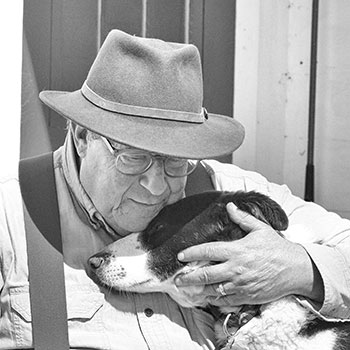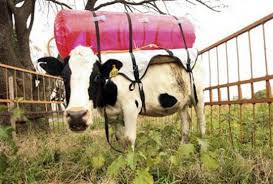Every Dog Deserves A Second Chance
Jon Katz, Second Chance Dog
 Bestselling author Jon Katz is back on Animal Radio. Years ago he was on top of the world. Then came the end of his 35-year marriage and he went broke. He needed a second chance. Along came Frieda, a Rottweiler-shepherd mix that also needed a second chance. Jon said "I had no idea that Frieda would enter my life and alter it in the most profound way, but that's one of the beautiful things about animals. They change you, and you almost never see it coming."
Bestselling author Jon Katz is back on Animal Radio. Years ago he was on top of the world. Then came the end of his 35-year marriage and he went broke. He needed a second chance. Along came Frieda, a Rottweiler-shepherd mix that also needed a second chance. Jon said "I had no idea that Frieda would enter my life and alter it in the most profound way, but that's one of the beautiful things about animals. They change you, and you almost never see it coming."
Fortunately, at the time Jon was living in upstate New York and he was looking for someone to share his life with, and the person turned out to be right across the street in one of his barns. Maria Wolf was an artist who was renting his barn at the time.
While he and Maria grew closer, Jon was having a tough time gaining her dog, Frieda's, trust. Frieda is a Rottweiler-Shepherd mix who was a junkyard dog that had been abandoned by her previous owner in the Adirondacks, where she lived on her own for three years. It took the SPCA a year to catch her, where she then lived for another year.
It was love at first sight for Maria. She thought Frieda was adorable! The SPCA basically said just take her, with no forms to fill out and no home check, they just wanted her adopted!
 When Jon met Maria and Frieda, he compared them to Thelma & Louise, stating that they were both man-haters. Jon knew he was not going to get Maria if he didn't work things out with Frieda. Frieda was ferociously protective and barely tamed. She roared and charged at almost anyone who came near. Jon even called her the "Hell Dog." But to Maria, Frieda was sweet and loyal, her beloved guard dog and devoted friend. Armed with a singular determination, unlimited patience, and $500 worth of beef jerky, Jon refused to give up on Frieda, or on his chance with Maria.
When Jon met Maria and Frieda, he compared them to Thelma & Louise, stating that they were both man-haters. Jon knew he was not going to get Maria if he didn't work things out with Frieda. Frieda was ferociously protective and barely tamed. She roared and charged at almost anyone who came near. Jon even called her the "Hell Dog." But to Maria, Frieda was sweet and loyal, her beloved guard dog and devoted friend. Armed with a singular determination, unlimited patience, and $500 worth of beef jerky, Jon refused to give up on Frieda, or on his chance with Maria.
It took about six months before Jon was actually able to get a leash on Frieda. He said it was a very challenging training experience. Frieda lived in the barn, and it was another six months before he was able to get her in the house and surprise Maria, which occurred on a Christmas Eve.
After that, Frieda become Jon's writing dog. She sat in front of his study and guarded the door. As a result, no one bothered Jon when he was writing, and he became crazy about her! She was also the muse for his book, Second Chance Dog.
Visit Website
Marijuana Killing Animals
Elyce Kirchner, Investigative Reports NBC In San Francisco
 Over half-a-million marijuana plants have been recovered on US Forest Service land. It's a form of trespassing on National Parks that's abusing the land as farmland. However, it's not what they're growing but how they're growing it, that's killing wildlife, tainting water supplies and endangering hikers.
Over half-a-million marijuana plants have been recovered on US Forest Service land. It's a form of trespassing on National Parks that's abusing the land as farmland. However, it's not what they're growing but how they're growing it, that's killing wildlife, tainting water supplies and endangering hikers.
While Elyce Kirchner told us that has been a lot of talk about the controversy surrounding the legalization of marijuana, there was little talk about what growing it was doing to the environment. It has been found that illegal pesticides are wreaking havoc on our national parks and on federal land in California. The growers are using these pesticides to keep the animals away, without realizing what impact it is having on the environment and wildlife.
One such rare species of animal, called the Pacific Fisher, a raccoon sized animal, is being impacted the most. Researchers found of the 300 that were still alive in northern California, six died from ingesting the chemicals (per the necropsy results). They estimated 86-percent of the living population had been exposed to the chemicals, meaning, there is a marijuana grow site using them in their habitat. They also found two spotted owls that were exposed and fear the Humboldt Marten and Sierra Nevada red fox will be impacted as well. These pesticides are similar to rat poison, and are so strong, a 1/4 teaspoon can kill a lion.
 Volunteers, dedicated to reclamation of the land to its natural state after marijuana grow sites have been removed, were crying out for more funding to not just eradicate the plants, but to clean up the toxins left behind that are impacting the environment.
Volunteers, dedicated to reclamation of the land to its natural state after marijuana grow sites have been removed, were crying out for more funding to not just eradicate the plants, but to clean up the toxins left behind that are impacting the environment.
At one point, a government task force in California spent $23 million hunting down and seizing marijuana plants on public land, but there was little funding set aside for the cleanup, which was all left for the volunteers.
Because these chemicals and pesticides are so strong, they stay in the land for a long time. Members of the Hoopa Valley Indian Tribe also feared the environmental impacts since their water supplies run close to the locations where the deadly chemicals were used, and they are no longer drinking from the river, which they did for generations.
Suffering In Silence
Dr. Marty Becker, America's Veterinarian
 Often when an animal is sick it goes un-noticed. Some believe that's because they can't show weakness in the wild, or they will be attacked. Animal Radio Veterinary Correspondent Dr. Marty Becker will tell you what signs to look from problems such as dental, brain aging, metabolic, and chronic pain; how these can be diagnosed and treated; all which indicate your furr-kid is sick.
Often when an animal is sick it goes un-noticed. Some believe that's because they can't show weakness in the wild, or they will be attacked. Animal Radio Veterinary Correspondent Dr. Marty Becker will tell you what signs to look from problems such as dental, brain aging, metabolic, and chronic pain; how these can be diagnosed and treated; all which indicate your furr-kid is sick.
Some signs are that their activity level is not the same; their eyes might look dull; their appetite has changed; and their bathroom habits might have changed. If a dog that normally chows down his food doesn't want to eat, there's usually something wrong; if a dog that normally chases everything and loves going on walks is all of a sudden not interested in any of these things, there's usually something wrong; and if they normally have firm stools and all of a sudden their stools are soft or runny, there's usually something wrong. You don't have to be a veterinarian to notice these things.
You may also see your dog not eager to jump in the car or get up or down on the couch or bed. They may also refuse to go up or down stairs. When they walk, instead of one leg after the other, the may do a bunny hop with the back legs moving at the same time. They may also have a hard time getting into a standing position.
 For cats, if a cat skips a meal, that is usually a pretty serious medical issue, and you should see a veterinarian right away. They have probably been hiding this for weeks and you just haven't noticed it. They may also stop using the litter box all of a sudden, because it is too painful to climb over the edge; they may also stop grooming themselves in hard to reach spots; they may also not want to get up in the window or climb the scratching post; or that may also not do their morning stretch and sharpen their claws like they normally would. Again, you don't have to be a veterinarian to notice these things.
For cats, if a cat skips a meal, that is usually a pretty serious medical issue, and you should see a veterinarian right away. They have probably been hiding this for weeks and you just haven't noticed it. They may also stop using the litter box all of a sudden, because it is too painful to climb over the edge; they may also stop grooming themselves in hard to reach spots; they may also not want to get up in the window or climb the scratching post; or that may also not do their morning stretch and sharpen their claws like they normally would. Again, you don't have to be a veterinarian to notice these things.
You may also see signs in the temperaments of both cats and dogs. Your normally laid back dog might even start to growl at you or you cat will hiss. When they do this, you know they are in a lot of pain.
When you do bring these pets to the veterinarian's office, they get really anxious and they have this epinephrine surge, which masks their pain and discomfort. They will then start to walk and act normal, without any signs of discomfort. It is best during these visits that hey have little or no anxiety so your veterinarian can get an accurate account of what's happening.
 Dr. Becker tells us one case where an animal was obviously in pain, but all blood work came back normal. They then decided to do x-rays of the teeth, where they found a severely abscessed tooth.
Dr. Becker tells us one case where an animal was obviously in pain, but all blood work came back normal. They then decided to do x-rays of the teeth, where they found a severely abscessed tooth.
We all know our pets, and Dr. Marty Becker is no exception. He says he can tell within 5 seconds of looking at one of his pets that they don't feel well, and you should be able to do the same with yours.
Visit Fear Free Happy Homes for tips on making your home fear free and to locate a Fear Free Veterinarian near you. Go to Fear Free Pets to become certified.
Listen and Explore the Fear Free Expert Series
Pheromones In Puppy Training - Dr. Debbie

So you just got a new puppy and you have all your training tools at the ready, the collar, leash and dog crate. But beyond that, do you have the one thing that can make your training tasks easier all around? Tap into your puppy's own sense of smell using canine pheromones and ease your new pup's training and transition into the home.
Pheromones are scent signals emitted by all animal species, including humans. Various pheromones work under the radar to influence the perceptions and behaviors of others within a species.
Shortly after whelping, a pheromone is emitted from the bitch's sebaceous (oil) glands located between the mammary glands. The pheromone, dubbed the canine appeasing pheromone, reassures the puppies, calms them and facilitates nursing. The bitch stops emitting this pheromone as the pups mature, but all dogs retain the ability to "read" this pheromone. Not only do older dogs recognize this pheromone, but it continues to have a natural calming effect on canines of all ages.
In veterinary behavior cases, the dog appeasing pheromone is used for dogs with noise phobias, car travel anxiety, separation anxiety and other fearful situations. Various forms are available including pheromone collars, plug in diffusers and sprays. The canine appeasing pheromone doesn't sedate the dog; rather it decreases fear and excitability.
The dog appeasing pheromone is also helpful for newly adopted puppies. Those first few days to weeks in a new home are full of changes for the pup faced with novel environments far from the comfort of mother and siblings. The dog appeasing pheromone has been shown to ease the transition of the pup into new home and improve sociability and training during a pup's critical socialization period.
Pheromone Research
For skeptics that need to see the proof in the studies, veterinary behavior studies have examined the positive influence of the dog appeasing pheromone. When comparing treatment responses for dogs with separation anxiety, the use of the dog appeasing pheromone equaled the benefit of the anti-anxiety medication, amitriptyline.
One study looked at 66 puppies as they settled into new homes after adoption. Approximately half of the puppies wore a pheromone collar and half wore a placebo. The study found that puppies wearing a pheromone collar displayed significantly fewer nuisance behaviors like vocalizations or scratching within 3 days of adoption. Pups wearing the pheromone collar woke their owner's less during the night and displayed fewer signs of distress and vocalizations throughout the course of the study.
The researchers concluded that pheromone collars helped both the pup and family. Pups were less stressed and adapted easier. By decreasing the pup's stress and fearful behaviors, the pet owners found a more enjoyable bonding experience with the new pup and faced less frustration through the training process.
 In another study, puppies 8 to 15 weeks were enrolled in an eight-week long puppy socialization and training class. Half wore a pheromone collar and the other half wore a placebo collar. The pups wearing the pheromone collar were calmer in the face of novel experiences and displayed less fear, anxiety, and aggression. In the end, the pups with the pheromone collar not only were less nervous, but had fewer behavioral problems and learned better. And a long-term effect on sociability was recognized in dogs up to one year after the class and study was completed.
In another study, puppies 8 to 15 weeks were enrolled in an eight-week long puppy socialization and training class. Half wore a pheromone collar and the other half wore a placebo collar. The pups wearing the pheromone collar were calmer in the face of novel experiences and displayed less fear, anxiety, and aggression. In the end, the pups with the pheromone collar not only were less nervous, but had fewer behavioral problems and learned better. And a long-term effect on sociability was recognized in dogs up to one year after the class and study was completed.
Pheromones and My Pup
As a previous owner of a nine-week old Bouvier puppy named Nikki, I used both the pheromone collar and diffuser upon welcoming my new pup home. One day before bringing Nikki home, I placed a pheromone diffuser close to the puppy crate, where it would have maximum benefit during her first nights in the kennel away from mother and siblings. Immediately upon leaving the breeder's home, Nikki was fitted with a pheromone collar to serve as a source of reassuring pheromones that went everywhere she did. The pheromone collar became a tool in Nikki's socialization. It was on her when she met new people or animals, when she explored new environments and during puppy kindergarten class.
Did pheromones help in my pup's transition and training? The four hour drive home from the breeders was a dream, no crying or whining the entire trip. After returning home, Nikki never soiled in her kennel during the day or night. I'll admit I had my share of interrupted sleep in the first two weeks, but most of Nikki's night time wakes were for genuine elimination needs. Overall, her transition into the home was smooth and lacked the wailing, inconsolable cries of a stressed pup.
The canine appeasing pheromone isn't a magic bullet though. Nothing matches a quality pup obtained from a reputable breeder who focuses on health, genetics and early socialization. Likewise, pheromones do not replace the hard work and consistent training efforts that any new pet owner must provide. However, by adding the the canine appeasing pheromone to your new puppy training, you can help your pup become the best he or she possibly can.
Featured veterinarian known as "Dr. Debbie" on national pet radio program, Animal Radio. Ebook author of "Yorkshire Terriers: How to Be Your Dog's Best Friend"; "Pugs: How to Be Your Dog's Best Friend"; "Mini Schnauzers: How to Be Your Dog's Best Friend"; and "Shih Tzu: How to Be Your Dog's Best Friend." Dr. Debbie's books.
Visit Website
Animal Radio News with Stacey Cohen
 Cow Gas Turned Into Fuel
Cow Gas Turned Into Fuel
Argentine scientists found a way to transform the gas created by the bovine digestive system into fuel, an innovation that could curb greenhouse gases that cause global warming. Using a system of valves and pumps, the experimental technique developed by Argentina's National Institute of Agricultural Technology (INTA) channels the digestive gases from bovine stomach cavities through a tube and into a tank. The gases, which otherwise are commonly known as burps, or "eruptos" in Spanish, are then processed to separate methane from other gasses such as carbon dioxide. Methane is the main component of natural gas, used to fuel everything from cars to power plants.
 Let Your Pets Do The Holiday Cards This Year
Let Your Pets Do The Holiday Cards This Year
Well its here, that time of year when you think about holiday cards. Nowadays lots of people use electronic ones, so how about your pet doing the card this year? My Talking Pet is a program from WOBA Media that lets you animate the mouths of animals and people in photos and with sound file make them talk. You can upload your own photo or choose from a gallery, speak a message into a microphone and then share it as a video greeting on Facebook or e-mail it out to friends.
Animal Awards - Dogs Are Cutest - Snakes Are Scariest!
Dolphins are smart, dogs are adorable, elephants are powerful and rattlesnakes are frightening. Those are the findings of "Animal Awards." Nearly a third of the respondents gave dolphins the nod for brains and considered them the "most intelligent" animal. But a large percent thought chimpanzees were the smartest, with dogs taking third place. But dogs ranked first for looks, with most believing our canine friends deserved the "most cute" title. Cats landed in the number two spot, with rabbits having third place. Meanwhile, a good chunk have no desire to encounter a rattlesnake, which was named the "scariest" animal.
Worst Flea Infestation Ever
The warm temperatures and relatively dry summer, in combination with a mild winter last year, opened up the to a flea infestation. Dogs and cats appear to be equally affected, and being indoor-only does not seem to guarantee immunity to the problem. In addition to environmental factors, several social factors play a role in the increase in flea infestations, namely more dog-dog interactions (at a daycare, dog park, or pet-friendly workplace) and multi-family dwellings (condominiums and apartment complexes with common hallways). Dogs can easily expose indoor cats to fleas as well, so it appears nobody is safe. Prevention of the infestation is obviously the best measure to avoid problems. Many products exist which, when used properly, can safely protect a pet from infestation. Some over-the-counter products, in addition to being somewhat ineffective, have been linked to adverse reactions and pet deaths, so talk to a veterinarian before starting a product.
 Wedding Proposal With The Help Of A Dolphin
Wedding Proposal With The Help Of A Dolphin
A British man said he got a quick "yes" when he proposed to his girlfriend via a dolphin. The man planned the romantic gesture when he and his fiancee were in Florida for a family wedding. He fulfilled one of her dreams by taking her swimming with dolphins, and then made her even happier when he had one of the marine animals swim toward her with a buoy that said "Will you marry me?" However, the dolphin wasn't responsible for the engagement ring. The man planted it back on the beach for her to get when they returned to dry land.
 Listen to the entire Podcast of this show (#1302)
Listen to the entire Podcast of this show (#1302)





